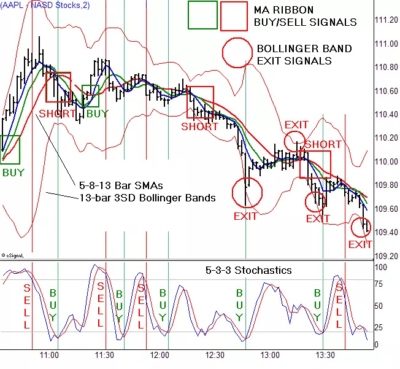If the outer channel line is steep, it’s probably a strong trend and not a Keltner Channel Squeeze. This means it has an upper and lower boundary to help you identify potential “overbought and oversold” levels. DTTW™ is proud to be the lead sponsor of TraderTV.LIVE™, calculated bets the fastest-growing day trading channel on YouTube. You can also select whether you will apply this action on the opening or closing price. While we recommend using the default settings, you can tweak these figures to meet your preferred criteria.
- Whereas, the middle line of the Bollinger Bands Indicator is based on the simple moving average .
- With its averaging effect, some feel that typical price offers a better representation of price action, compared to using closing prices alone.
- The stock did not manage to reach the upper channel line, but did get close as it reversed in the resistance zone.
- Also similar to the Bollinger Band® technical indicator, STARC bands are calculated to incorporate market volatility.
Bollinger Bands and Keltner Channels are technical indicators that are used to measure the volatility of the price of an asset. Keltner Channels are a populartechnical indicatorthat day traders can use to help assess the current trend and provide trading signals. The channels use volatility and average prices to plot upper, lower, and middle lines. All three of these lines move with the price, creating a channel-like appearance. Armed with the prospects of a weak trend and trading range, traders can use Keltner Channels to anticipate reversals. In addition, notice that the channel lines often coincide with chart support and resistance.
Bollinger Bands®
If the candles start to break out of the top band, then the move will usually continue to rise. If the candles start to break out below the lower band, then the price will usually continue to fall. The channels or bands describe the outer boundaries of the normality of the price change. It also establishes where a band of likely support or resistance levels might lie.
However, STARC bands do act in the trader’s favor by displaying the best opportunities. If this indicator is coupled with disciplined money management, the FX enthusiast will be able to profit by taking on lower-risk initiatives and minimizing losses. Let’s take a look at an opportunity in the New Zealand dollar/U.S. Placing effective entries, the FX trader will have the opportunity to effectively capture profitable swings higher and at the same time, exit efficiently, maximizing profits. The theory behind the signals may seem a little confusing at first, as most traders assume that a break of the upper or lower boundary signals a reversal, but it is actually quite simple.
Consequently, as stated above,Bollinger Bands have a greater potential than Keltner Channels for producing false signals. Hence,how you incorporate the signals from Bollinger Bands will completely be dependent on your overall trading strategy. By checking the location of the security price with respect to the upper and the lower lines of the Bollinger Bands indicator, you can get a fair idea on the momentum of the price trend. In 2010, Kaunas University of Technology published a study on the use of Bollinger Bands in the Baltic Stock Market that made a similar recommendation based on a series of statistical tests. I spent 20 months chasing these late day bloomers before finally realizing this wasn’t my calling. In the below example, we will dig into whether the Keltner Channels or Bollinger Bands can better detect when a stock is beginning to trend late in the day.

The effectiveness of the Keltner indicator was proven when analyzing previous price performance for Bitcoin. Whenever the price traded above the upper Keltner line, Bitcoin made record all-time highs. Whenever the price dropped below the two Keltner lines, it entered a bear market.
Defining the Squeeze
However, it is worth noting that there is a strong possibility that you may get “paralysis through analysis,” which can happen when you start combining similar indicators and wait for the perfect setup. Keltner Channels can be found in SharpCharts as a price overlay. As with best forex trading apps a moving average, Keltner Channels should be shown on top of a price plot. Upon selecting the indicator from the dropdown box, the default setting will appear in the parameters window (20,2.0,10). The first number sets the periods for the exponential moving average.
Again, if you are looking for more technical articles on the two indicators, there are tons of posts on the web. I figured I would just stick to the comparison and leave the number-crunching up to the mathematicians. The STOCHASTIC indicator is among the most popular trading indicators and rightfully so.
When conditions are right for each strategy, though, they tend to work well. Since the market is typically volatile right after the open, you may get one signal that results in a loss or small profit, immediately followed by another signal. Take only two trade signals for this strategy in the first 30 minutes. If a big move doesn’t occur on the first two channel breakouts, then it probably isn’t going to happen. Sell short during a downtrend when the price rallies to the middle line.
Happy Trading!
This gives us the best perspective on Bitcoin’s long-term price action. We can see that Bitcoin was trading above the upper band when it rose from $10,000 to $60,000 near the end of 2020 and the start of 2021. Keltner Channels give us an indication as to whether the price is trending or going sideways – allowing us to open long and short position. If the price of Bitcoin is within the two bands, it’s likely going sideways. If the price is trading above all Keltner Channel bands, it’s trading upwards and we could open a long position or a short position expecting a pullback.

Keltner Channels give traders a quick visual guide to a security’s average price and volatility. Traders can use this to identify securities that have moved well outside of where they normally trade. This could present an opportunity to trade the security as it moves back into the trend zone. If the security holds price action outside of the Keltner Channel, that could signal a trend change or “breakout,” and that presents a different set of trading opportunities.
What Is Keltner Channel?
Continually check to make sure the market is following the pattern for the trading guidelines; if it isn’t, don’t use this strategy. The indicator should be set up so these guidelines hold true most of the time. In other words, if the price is moving continually higher but not reaching the upper band, then your channels may be too wide and you should lower the multiplier. If the price is continually trending higher but often touches the lower band while doing it, your channels may be too tight and you should increase the multiplier. To use most indicators, it is always important to check out the inputs.
Keltner Channels are more sensitive to price changes, and many technical analysts argue that they give a better indication of the true trend. Bollinger Bands are more commonly used, but Keltner Channels could be a better option for traders who want to use a more accurate indicator. We introduce people to the world of trading currencies, both fiat and crypto, through our non-drowsy educational content and tools. dynamic trailing stop We’re also a community of traders that support each other on our daily trading journey. In a DOWNTREND, price action usually hangs around the BOTTOM HALF of the channel, finding resistance at the middle line and support at the bottom line. In an UPTREND, the price action tends to be confined in the UPPER HALF of the channel, which is between the middle line as support and the top line as resistance.
The ATR measures volatility or how extensive the price moves are for a commodity or currency over a set period. The Keltner Channel day trading breakout strategy is designed for use right around the open of a major market and only in assets that tend to have sharp and sustained moves during that time. The trend-pullback strategy is more applicable throughout the day, and the only requirement for the strategy is that a trend that meets the guidelines occurs. Usually when traders use these indicators, they will change the default settings for one of them. The idea behind using both together is that if the Bollinger Bands and the Keltner Channels both give signals in the same direction, that is when you buy or sell, based upon what they both tell you.
The Squeeze
The volatility multiple will be optimized form 0.25-3, in steps of 0.25. For the Bollinger Bands, volatility multipliers over 3 produce too few trades for a meaningful comparison. Average true range also tends to be less volatile than standard deviation, creating bands which are smoother but contain more lag. By default, both indicators use a 20-bar lookback period and a volatility multiple of 2. The upper band and lower band are calculated based on the EMA and the default settings. The upper envelope signals resistance levels and the lower band signals support levels.
Markets and Timeframe
There are three lines on the chart, including a “mean price” and 2 x Average True Range, both above and below that level. These preset values can be customized and changed by the trader. The better indicator will come down to the way an individual trades. The main difference is that the Keltner Channel represents volatility using the high and the low prices of a specific timeframe, while Bollinger Bands represent standard deviation.
Detecting Market Reversals Using a New Technique .
Notice how the Keltner Channels are smoother than the Bollinger Bands. Also, notice how the Standard Deviation covers a larger range than the Average True Range . When the bands squeeze together, it usually means that a breakout is imminent. Expanding volume on a breakout is a sign that traders are betting with their money that the price will continue to move in the breakout direction.
If the market breaks out beyond this boundary, we are alerted of an unusual occurrence and can plan our trades accordingly. Finally, we can summarize that neither indicator is superior over the other. Personally, I prefer the Bollinger Bands® because of the statistical component of the standard deviation. Without getting too much into statistics at this point, the standard deviation is used to calculate confidence intervals. This means that when the Bollinger Bands® are set to 2 standard deviations, only 5% of all price action should be outside of the bands.
